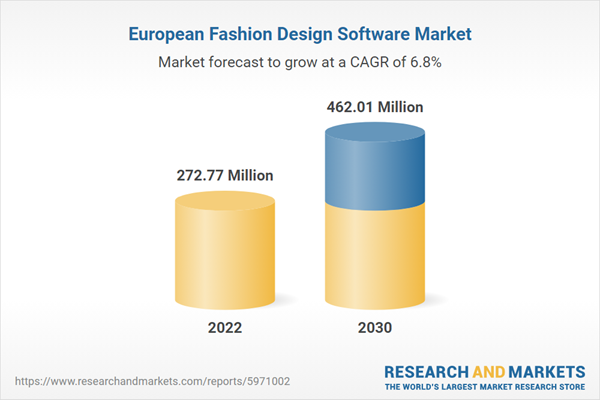Advent of AI, VR, and AR Fuels the Europe Fashion Design Software Market
Advanced technologies such as AI, AR, and VR are transforming the fashion industry from physical to digital spaces. This digital transformation is creating various opportunities for collaboration between the fashion and technology industries. For instance, in June 2021, CLO Virtual Fashion, which develops true-to-life, 3D garments simulation technology for fashion and film/gaming industries, launched CLO-SET Connect - a global community of fashion creators. It is a platform that empowers digital assets through an open marketplace, portfolio management tools, and networking solutions. Various vendors and creators are connecting through this platform, which is anticipated to offer promising growth opportunities for the fashion design software market.Furthermore, various market players are integrating advanced technology, such as AR and VR technologies, with their shopping platforms in order to enhance the customer experience. For instance, in June 2022, Amazon launched a new Virtual Try-On for Shoes feature that helps customers visualize a pair of shoes before purchasing through their mobile phones. This AR technology aids in deepening the sense of ownership of the customer, which enhances the customer buying experience. Furthermore, various start-ups are offering cutting-edge technology, such as digital twins, VR, and AI. For instance, Veesual AI, a French start-up that was established in June 2020, offers virtual try-on experiences for the fashion and e-commerce industries. With the help of AI, the company combines images of clothing and customers with photorealistic results. In 2019, the high-end Italian company Gucci developed an augmented reality-enabled iOS app that lets users try on its"Ace sneakers collection virtually and remotely." Gucci and the multimedia messaging service"Snapchat" also worked together to provide a virtual trying-on experience via the app. It was the first high-end clothing company to use augmented reality (AR) to increase sales by collaborating with a social media network. Additionally, Timberland and Lemon & Orange partnered to be among the first companies to introduce virtual fitting rooms to Poland's Mokotów Gallery, a shopping center. In January 2022, H&M debuted its first virtual apparel line through a competition in which contestants were asked to create inventive and creative names for the featured styles. Burberry is one of the top players in the fashion industry that is enthusiastic about AR. It has included AR in several web platforms and is still experimenting with it in its global campaigns. Also, in 2019 Adidas launched a footwear try-on via their smartphone app, allowing users to digitally try on a selection of running shoes and some of their most recognizable brands. Thus, with the advent of AI, AR, and VR, the digital fashion industry is growing, which is likely to offer lucrative opportunities for the fashion design software market growth in the coming years.
Europe Fashion Design Software Market Overview
Europe is leading the way in making the fashion industry more environmentally friendly. The European Union's stringent regulations emphasize longevity, responsible usage, and reduced waste. These changes are prompting fashion brands to adopt higher quality and sustainable practices. Cutting-edge technologies such as SwatchOn's 3D fabric library are redefining design processes. As companies strive to adhere to new regulations and create eco-friendly products, the role of fashion design software becomes increasingly critical in supporting greener and more innovative practices. Various European countries are experiencing remarkable growth within this transformative landscape. Countries such as Italy, France, and the UK are emerging hubs for fashion design software utilization, embracing cutting-edge tools to drive creativity, efficiency, and ecological responsibility in the fashion sector. This collective momentum across European countries further reinforces the region's status as a driving force in shaping the global fashion industry toward a more sustainable and technologically advanced future.Europe Fashion Design Software Market Segmentation
The Europe fashion design software market is segmented based on type, end user, and country.Based on type, the Europe fashion design software market is bifurcated into 2D software and 3D software. The 3D software segment held a larger share in 2022. The 2D software is further subsegmented into apparel, gaming, and media. The 3D software is further subsegmented into apparel, gaming, and media.
By end user, the Europe fashion design software market is segmented into enterprises, individuals, and institutions. The enterprises segment held the largest share in 2022.
Based on country, the Europe fashion design software market is segmented into Germany, France, Italy, the UK, Russia, and the Rest of Europe. The UK dominated the Europe fashion design software market in 2022.
Adobe Inc, Autometrix Inc, Browzwear Solutions Pte Ltd, CLO Virtual Fashion LLC, Lectra SA, Optitex Ltd, Strategies SA, and Tukatech Inc are some of the leading companies operating in the Europe fashion design software market.
Table of Contents
Companies Mentioned
- Adobe Inc
- Autometrix Inc
- Browzwear Solutions Pte Ltd
- CLO Virtual Fashion LLC
- Lectra SA
- Optitex Ltd
- Strategies SA
- Tukatech Inc
Table Information
| Report Attribute | Details |
|---|---|
| No. of Pages | 98 |
| Published | February 2024 |
| Forecast Period | 2022 - 2030 |
| Estimated Market Value in 2022 | 272.77 Million |
| Forecasted Market Value by 2030 | 462.01 Million |
| Compound Annual Growth Rate | 6.8% |
| Regions Covered | Europe |
| No. of Companies Mentioned | 8 |









